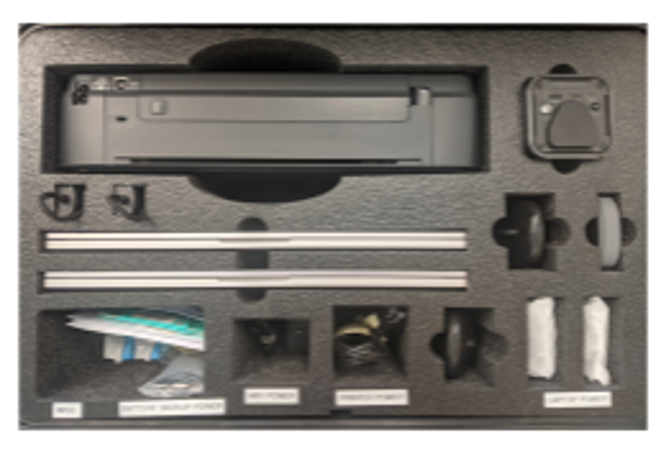
The Council of State Governments (CSG) Overseas Voting Initiative (OVI) 2019 report Examining the Sustainability of Balloting Solutions for Military and Overseas Voting, said “states are under increasing legislative pressure to have contingency plans in place for all aspects of their election systems, including the Uniformed and Overseas Citizens Absentee Voting Act (UOCAVA) balloting solutions, due to recent national disasters such as Hurricane Sandy, Hurricane Maria and Hurricane Dorian, and global threats of terrorism, civil disobedience, cyberattacks and mail service disruptions.” A case study in emergency preparedness can be found in New Jersey.
Superstorm Sandy is known as such because it was more than just a hurricane that ripped through the East Coast of North America beginning on October 22, 2012. Sandy was a Category 3 hurricane followed immediately by a post-tropical cyclone that made landfall in rapid-fire succession over several days. The storm did not end until November 2 after killing at least 117 people in the United States plus 69 people in Canada and the Caribbean. It also left $68 billion in destruction in its wake, even forcing the closure of the New York Stock Exchange for two consecutive days, the first time this happened since 1888 due to a weather catastrophe.
The state of New Jersey sustained a great deal of damage as a result of Sandy. Election Day in 2012 – a presidential election year – was on November 6, just four days after Superstorm Sandy ended. State and local election officials in affected areas – especially in hardest hit New Jersey – worked in response to ensure citizens displaced or disrupted by the storm were able to exercise their right to vote. Sandy was obviously no easy situation to manage, but a scenario not unfamiliar to election officials across the nation.
Election officials are some of our nation’s greatest go-to resources for contingency planning and logistical challenges. They are leaders in thought and action when it comes to disaster preparedness and resilience of operations. Elections must always happen as scheduled, in spite of any hurdle, disruption, or disaster. New Jersey election officials in a post-Sandy environment certainly typify this statement.
If a state is going to supply its counties with necessary tools for today’s ever-evolving technology and security environments, they wanted to make their investment – paid for through the Help America Vote Act Election Security Funds – stretch as far as possible to include tools for disaster recovery, contingency planning, redundancy, and sandboxing for UOCAVA and other electronically returned ballots.
Thus, in addition to the Chromebook with its sandboxing environment, New Jersey’s Go Bags were later augmented to include a second Chromebook to serve as a redundant back-up, as well as a printer, a hot spot router, multiple power supplies, paper, and pens. These items were then fitted in secure, durable hard-shell cases for each local election office.
New Jersey’s aptly-termed “Go Bag” is an example of a statewide initiative to enhance contingency planning. Local election jurisdictions can be prepared for all types of unforeseen circumstances and emergencies that can negatively impact the administration of elections in their state.
New Jersey’s Go Bag is a portable election office, developed by the New Jersey Division of Elections team as a contingency plan and business process continuity tool. It contains the necessary supplies for local election officials in New Jersey’s 21 counties to conduct business from anywhere and meet multiple disaster scenarios.
In addition to its role in business continuity efforts, the Go Bag also serves as a stand-alone workstation. It enables the detection and mitigation of malware and other cybersecurity threats from email attachments and other electronic files received by local election officials.
Each Go Bag contains a dedicated, stand-alone, mobile Chromebook workstation with a “sandboxing environment,” for retrieval of electronic ballots, as New Jersey law permits military and overseas citizen ballots to be returned electronically. New Jersey typically requires a mailed ballot as well, but that requirement may be waived in a declared emergency. A sandbox is a separate, partitioned environment where electronic ballot attachments can be opened securely by election officials to isolate potential viruses or other malware prior to an email entering the local network or mail server. If threatening activity is detected, the email is flagged and the election officials is prevented from unknowingly opening the malicious content, thereby infecting their network. Thus, sandboxing provides New Jersey’s local election offices with a more protective environment where electronic ballot attachments and other balloting materials can be opened securely – and separately from their other systems potentially averting a major issue. For reference, New Jersey’s sandboxing environment deployment is similar to the technology implementation in South Carolina as described in this OVI article.
It’s important to note that New Jersey’s local election duties are divided among multiple county offices. County clerks use the sandboxing solution to process military, overseas citizen, and vote-by-mail applications, while the county boards of election use them to safely open returned electronic ballots from voters authorized to cast electronic ballots. Therefore, the state purchased 51 sandboxing environments – and 51 Go Bags – for all the local election official offices across their 21 counties including county clerks, board of elections offices, and in the case of New Jersey’s larger counties, the county superintendents of elections /commissioners of registration.
New Jersey’s dual purpose “Go Bag” for each of its 21 counties equipped with two Chromebooks, a printer, a hot spot router, multiple power supplies, paper, and pens in a case.
New Jersey’s Go Bags are an effective tool for mitigating cybersecurity risks and enabling continuity of election operations in the face of unforeseen logistical challenges in any type of emergency. Thus, we’re sharing this implementation overview from New Jersey in the event it helps other states and local jurisdictions who are considering various election risk mitigation strategies. We also encourage state and local election officials to share their ideas or proven methods with us by emailing us at [email protected].
The post <strong>Sandboxes and “Go Bags”: How New Jersey Election Officials Prepare for Crises</strong> appeared first on CSG OVI.





